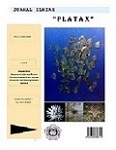In Vitro Culture of Seaweed Kappaphycus alvarezii under Different Formulation of Growth Stimulating Substances and Culture Media
DOI:
https://doi.org/10.35800/jip.7.1.2019.23375Abstract
This study aims at obtaining a sustainably superior seed stock following the characteristics of the parent plant, determining the best formulation of the growth stimulating substance. In general, cytokinin and auxin combination was used, but this study also added with the combination of cytokinin and giberelin and cytokinin and abscisic acid (AA).Parameters measured were bud length, number of buds, and survival rate. Bacterial Vibrio sp test was also done as a cause of the explant mortality. Results showed that the longest bud was recorded in treatment C (S+A 1:2.5) cultured in a jar, 1.343 mm long, 38% of survival, while the highest number of buds was found in treatment B (S+A 1 : 2) 8.86. The shortest bud was recorded in treatment J (S + AA 1:2.5) cultured in a jar, 0.093 mm long, 2.64 buds, 10% of survival, while the explant cultured in the bottle had a length of 0.051 mm long, 1.50 buds, 4% of survival. As conclusion, the best growth stimulating substance was found in the treatment C for the bud length and the survival rate, while the best number of bud was recorded in the treatment B. The best culture tank was topless bottle (aerated). In vitro culture could also use S + G formulation. The explant mortality was caused by Vibrio charchariae. The use of S + AA formulation had lower growth than that of control treatment.
Keywords :in vitro, growth stimulating substance, culture media, Kappaphycus alvarezii, Vibrio charchariae
Â
ABSTRAK
Penelitian ini bertujuan untuk memperoleh benih unggul secara berkelanjutan yang mengikuti karakteristik dari tanaman induk, menentukan formulasi terbaik dari substansi pertumbuhan merangsang. Secara umum, kombinasi sitokinin dan auksin digunakan, tetapi penelitian ini juga menambahkan
kombinasi sitokinin, giberelin, sitokinin dan asam absisat (AA). Parameter yang diukur adalah panjang tunas, jumlah tunas, dan tingkat kelangsungan hidup. Bakteri Vibrio Uji sp juga dilakukan sebagai penyebab kematian eksplan . Hasil penelitian menunjukkan bahwa tunas terpanjang terdapat pada perlakuan C (S + A 1: 2,5) kultur dalam toples, 1,343 mm, 38% hidup, sementara jumlah tertinggi tunas ditemukan pada perlakuan B (S + A 1: 2) 8.86 . Jumlah tunas paling sedikit terdapat pada perlakuan J (S + AA 1: 2,5) yang dikultur dalam toples, 0,093 mm, 2,64 tunas, 10% hidup, sedangkan eksplan yang dikultur dalam botol memiliki panjang 0.051 mm, 1. 50 tunas , 4% bertahan hidup. Sebagai kesimpulan, pertumbuhan terbaik merangsang zat ditemukan dalam perlakuan C untuk panjang tunas dan tingkat kelangsungan hidup, sementara jumlah tunas terbanyak ditemukan pada perlakuan B. Penggunaan wadah budaya terbaik adalah topless yang diaerasi. Kultur in vitro juga dapat menggunakan formulasi S + G. Kematian eksplan disebabkan oleh Vibrio charchariae . Penggunaan formulasi S + AA memiliki pertumbuhan yang lebih rendah dari pada pengobatan kontrol .
Kata kunci : in vitro, zat perangsang tumbuh, media kultur, Kappaphycus alvarezii, Vibrio charchariaeDownloads
Published
How to Cite
Issue
Section
License
COPYRIGHT
Authors who publish with this journal agree to the following terms:
Authors hold their copyright and grant this journal the privilege of first publication, with the work simultaneously licensed under a Creative Commons Attribution License that permits others to impart the work with an acknowledgment of the work's origin and initial publication by this journal.
Authors can enter into separate or additional contractual arrangements for the non-exclusive distribution of the journal's published version of the work (for example, post it to an institutional repository or publish it in a book), with an acknowledgment of its underlying publication in this journal.
Authors are permitted and encouraged to post their work online (for example, in institutional repositories or on their website) as it can lead to productive exchanges, as well as earlier and greater citation of the published work (See The Effect of Open Access).




















